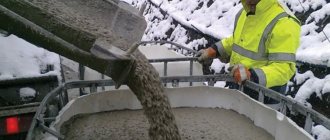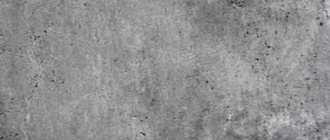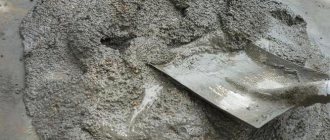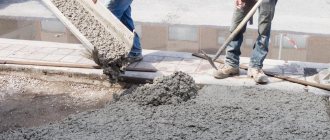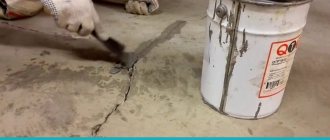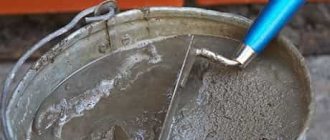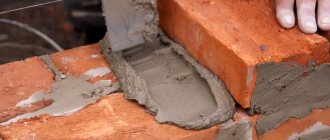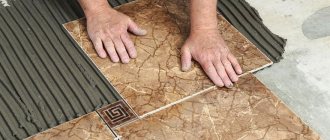Almost every construction process requires the use of masonry cement mortar. You can make it yourself, spending a certain amount of time and effort. Or you can purchase ready-made cement mixture.
There is a huge assortment of this material on the market and you can get confused before choosing it. After all, in order for the constructed structure not to collapse in the near future, but to serve for many years, you need to purchase the most suitable and high-quality masonry mortar. Therefore, before purchasing it, it is advisable to get to know it better and at the same time find out the price of this indispensable material for construction.
Types of mixtures
There are several classifications of ready-made and home-made CPR.
By cement content
The properties of the solution are determined by the ratio of sand and cement.
It is customary to distinguish the following types of compositions based on the cement content in the dry mixture:
- Normal . For 1 part cement there are 3 to 5 parts sand.
- Skinny . The composition includes more than 5 parts sand to 1 part cement. Such mixtures harden slowly and may crumble. The use of high grades of cement eliminates the disadvantage.
- Fatty . The mass fraction of sand is less than 3 to 1. Such compositions are prone to cracking. You can prevent the appearance of cracks by using high-strength cement grades 500 and higher.
Each mixture has specific areas of application.
By the number of binding components
The solution may contain additional additives that improve the astringent properties of cement when it comes into contact with water:
- lime;
- gypsum;
- magnesium powders.
Unlike cement, binders harden when exposed to air. Mixtures without additional ingredients are called simple, and those with gypsum, lime or magnesium are called complex.
Light and heavy
According to severity they are distinguished:
- light mixtures – up to 1.5 tons per m³;
- heavy mixtures - from 1.5 tons per m³.
Heavy mixtures are used for large-scale construction.
Strength marking
The strength of the cement-sand mortar determines the scope of its use:
- M50 . It is used for finishing floors and walls, as well as for sealing irregularities, small cracks and crevices.
- M100 . Used to make plaster, contains lime. It has a low price, eliminates cracks and noticeable changes during use.
- M150 . Universal products used for masonry mortars and plasters. Also used to create screeds. Apply in a layer of 5 to 50 mm.
- M200 . A durable composition that can be used for masonry mixtures, plaster, screed and foundations. Forms a dense and reliable layer.
- M300 . Used to create concrete mixtures, it costs more. Creates very strong foundations, but is not suitable for plasters.
High-strength cement grades M400 and M500 are expensive and are more often used in professional construction to create foundations.
In private construction, the best choice is mixtures of M100, M150 and M200. They are distinguished by their affordable price, ease of mixing and use.
Peculiarities
Considering cement masonry mortar separately, it is worth noting that it can be:
- normal;
- skinny;
- bold.
What kind of solution you use can be determined by its composition and degree of viscosity. If the solution leaves lumps and clots, it is a normal solution. Actually, if the solution is completely liquid, then it is skinny, if, on the contrary, the handle of the tool completely sinks in the solution, then it is fat. By using ready-made masonry mortar, you don’t have to think about such things, because it will immediately show its properties.
There is also a color mixture, which is used for the construction of any colored surfaces. An example would be brick. If you do not like the main color, then you can purchase colored masonry mortar from our website.
When choosing a warm material, pay attention to its composition. This is what will help you determine what type of mortar you need and how applicable it is for your type of construction.
Cooking technology and proportions
Normal solution is used most often due to harmonious proportions. Normal mixtures are durable and stable.
Valera
The voice of the construction guru
Ask a Question
The classic recipe for a normal CSP: 3 parts sand and 1 part cement. The composition is thoroughly mixed in dry form, and then water is gradually added, stirring with a shovel or drill with a mixer attachment.
The finished solution is smooth, thick, but not too runny or difficult to mix. To dilute 3 parts sand and part cement, 50% of their total volume of water is usually used. However, the use of different brands of cement can lead to an increase or decrease in this indicator.
When creating a certain brand of cement-sand mortar, different classes of cement are used. The table shows the recommended proportions of ingredients to obtain common brands of CPR.
| Solution grade, kgf/cm² | Cement brand | Proportions of cement and sand |
| 150 | 300 | 1:2,6 |
| 400 | 1:3,25 | |
| 500 | 1:3,9 | |
| 100 | 300 | 1:3,4 |
| 400 | 1:4,3 | |
| 500 | 1:5,3 | |
| 75 | 300 | 1:4,2 |
| 400 | 1:5,4 | |
| 500 | 1:6,7 | |
| 50 | 300 | 1:5,8 |
| 400 | 1:7,4 | |
| 25 | 300 | 1:9,5 |
The use of other brands of cement in private construction is not always required. Ultra-strong compounds are expensive, and less stable ones will not allow you to obtain a durable mixture.
Required Tools
When working with cement-sand mortar, you will need containers and construction tools:
- a concrete mixer or pallet if it is not available, as well as a large rectangular bowl or trough;
- spatula for laying and stirring;
- 15 liter bucket for measuring the volume of ingredients;
- a drill with a mixer attachment or a construction mixer;
- construction cone to control the mobility of the mixture.
To work with cement, you will need trowels, spatulas and other tools appropriate to the task.
For the foundation
To prepare foundations, it is customary to use high-quality cement mixtures - M400, M500.
Lime crushed stone must be added to the foundation base . It increases the strength of the coating.
After combining the dry ingredients, water is slowly added, as in the classical technology.
For screed
When preparing a solution for floor screed, you need to use grades of mixture from M150 and higher . The most commonly used composition is M200.
In non-residential premises, concrete screed is used without additional finishing (garages, basements, change houses). It is also used for laying parquet, linoleum, and laminate.
The screed mortar contains 1 part cement, 3 parts sand, 2 parts water. Sometimes crushed stone is used
For bricklaying
For bricklaying, the classic proportion . A composition with the addition of lime can also be used.
To make CPR M100, take : 1 part M300 cement and 3.4 parts sand. When using the M500 brand, add 5.3 parts of sand.
For plastering walls
When preparing a solution for plaster, you can use compositions with clay, lime, gypsum . Prepare a CFRP from 1 part cement and 3-6 parts sand. When working with 5 parts of sand or more, you need to take into account the reduced strength of the finished coating. You can also take up to 2 parts of lime for 1 part of cement. When preparing, sand and cement are first mixed, then a dough of lime and water is added.
What is added to the solution?
It is permissible to use various fillers and additives . It is difficult to list everything, because their number exceeds a hundred. But everything can be divided into groups that differ in their properties and purposes of application:
- To reduce hygroscopicity . These fillers reduce the porosity of the masonry material. The resulting mixture can be used for work in rooms with high humidity.
- To increase frost resistance . These additives make it possible to use the resulting mixture for external masonry work, since it will not be afraid of temperature changes.
- To increase strength .
- To increase ductility .
- To increase adhesion . Some masonry materials have poor “adhesion”; fillers in this group will help the masonry cement mixture adhere to them more easily.
Fillers and additives in the mixture can affect the amount of the main components. Some craftsmen try to improve the properties of the solution at home by adding lime, clay or salt to it. But it is very difficult to calculate the required amount of each material; incorrect calculation can lead to poor-quality masonry.
How to calculate consumption
Proper calculation of the consumption of cement-sand mixture will help save thousands of rubles. You need to be guided by the brand of the composition used and the data written on the packaging. The volume of the solution is calculated and multiplied by the cost per package (1 m³). The data is indicated in consumption per m³ - a layer 1 cm thick. To determine the consumption in m³, you need to multiply the value by 100. A classic example:
- light mixtures with lime and gypsum - 1.2 - 1.6 tons per m³;
- heavy mixtures of high grade cement - up to 2.2 tons per m³.
When calculating the consumption for screeding or plastering, the indicators are 25% of the volume of the covered area.
Question to the expert
How to save mixture?
The most common way to save money is to use fillers. When pouring screeds, expanded clay is added to reduce thermal conductivity. And lime additives are used for plastering. In some cases, ordinary cement can be replaced with high-quality cement to reduce its consumption.
Common mistakes and recommendations from experts
When working with CPR, you can make some mistakes:
- using stale mixture - it is advisable to use a fresh cement composition;
- incorrect choice of brand, non-compliance with the assigned tasks;
- failure to comply with mixing conditions;
- improper preparation of the base;
- Incorrect adherence to proportions when mixing independently.
Experts recommend strictly observing the proportions in accordance with the purchased mixture. If you do not have the skills to prepare solutions from individual components, it is better to abandon this idea in order to save money.
Other tips that will make working with cement-sand mortar easier:
- use beacons when leveling walls;
- look at the date when purchasing the composition - up to 6 months of shelf life;
- use the mixed solution within 2 hours;
- carefully add water and look at the volume;
- immediately wash containers and tools after work;
- use clay mixtures for finishing wood and plaster;
- use DSP only on a reliable basis;
- if you have no experience, choose the M300 brand, but no less.
If you have to work with the mixture for a long time, you can add 10-15% less sand to it, but so that the solution is not too liquid.
Kneading
How to properly dilute cement with sand? It does not take much time to prepare the solution, since all its components in the package come in certain correct and maximally correct proportions.
It is only necessary to mix these substances together in the correct algorithm so that they create exactly the plastic mass that will have the necessary properties and capabilities. First you just need to measure the amount of water that is needed according to the instructions for the material.
The kneading algorithm is as follows:
- Study all the manufacturer's recommendations , which are written in the instructions that come with the product packaging. It is best to follow exactly the rules that were determined by the company that manufactured the solution, since it may contain certain components that require a special approach to work.
- The ingredients in the correct sequence should be poured into a concrete mixer or a specially prepared container.
Concrete mixer
- After adding a small amount of water, the mixture must be stirred for a couple of minutes until a homogeneous mass is formed.
- The remaining amount of water should be added to the resulting material . After this, kneading should be done until the required plasticity and mobility of the solution is obtained. The optimal consistency is checked by tilting the container at an angle of 45 degrees.
- If the solution holds and does not flow out, then everything was done as correctly as possible and without adverse consequences.
If the cement mortar is too liquid, it is best to add a little sand to it. Otherwise, you need to add water.
Manufacturers of DSP
The construction market offers a huge number of ready-made dry mixes for preparing CPR:
- "Monolith" - Kirov mixtures M150, used for plastering, sealing joints, laying stone and brick.
- Knauf - legendary German mixtures of brands M75 - M200. Large selection to solve different problems.
- Construction service Novablock - the company produces standard and high-strength mixtures M300.
- "Adamant SPB" - mixtures for private and professional construction from M100 to M400.
- Dauer - durable but inexpensive German mixtures for installing blocks, bricks, pouring floors and finishing walls.
- "BaltPiterStroy" - mixtures from a large Russian manufacturer, a huge selection of brands for any task.
What is masonry cement mortar made from?
Ready-made cement mortar is a dry mixture that is used to fill all the free space between bricks, stone or concrete blocks and gives the resulting structure strength. It not only firmly holds all the elements together, but also does not allow cold and moisture to pass through and does not delaminate over time.
The main composition of the finished solution consists of:
- Aggregate (sand is most often used).
- The binder mixture is cement.
The ratio of these materials depends on the brand of masonry cement mixture.
